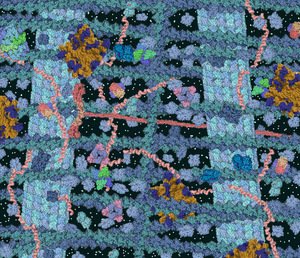
Back تزاحم الجزيئات الضخمة Arabic Crowding macromolecular Spanish Ateigamento macromolecular Galician 分子クラウディング Japanese

The phenomenon of macromolecular crowding alters the properties of molecules in a solution when high concentrations of macromolecules such as proteins are present.[2] Such conditions occur routinely in living cells; for instance, the cytosol of Escherichia coli contains about 300–400 mg/ml of macromolecules.[3] Crowding occurs since these high concentrations of macromolecules reduce the volume of solvent available for other molecules in the solution, which has the result of increasing their effective concentrations. Crowding can promote formation of a biomolecular condensate by colloidal phase separation.
This crowding effect can make molecules in cells behave in radically different ways than in test-tube assays.[4] Consequently, measurements of the properties of enzymes or processes in metabolism that are made in the laboratory (in vitro) in dilute solutions may be different by many orders of magnitude from the true values seen in living cells (in vivo). The study of biochemical processes under realistically crowded conditions is very important, since these conditions are a ubiquitous property of all cells and crowding may be essential for the efficient operation of metabolism. Indeed, in vitro studies have shown that crowding greatly influences binding stability of proteins to DNA.[5]
- ^ Goodsell DS (1991). "Inside a living cell". Trends Biochem. Sci. 16 (6): 203–6. doi:10.1016/0968-0004(91)90083-8. PMID 1891800.
- ^ Ellis RJ (October 2001). "Macromolecular crowding: obvious but underappreciated". Trends Biochem. Sci. 26 (10): 597–604. doi:10.1016/S0968-0004(01)01938-7. PMID 11590012.
- ^ Zimmerman SB, Trach SO (December 1991). "Estimation of macromolecule concentrations and excluded volume effects for the cytoplasm of Escherichia coli". J. Mol. Biol. 222 (3): 599–620. doi:10.1016/0022-2836(91)90499-V. PMID 1748995.
- ^ Cite error: The named reference
Minton2was invoked but never defined (see the help page). - ^ Cite error: The named reference
:0was invoked but never defined (see the help page).